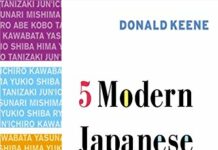
Ebook Info
- Published: 2003
- Number of pages: 232 pages
- Format: PDF
- File Size: 0.93 MB
- Authors: Donald Keene
Description
Yoshimasa may have been the worst shogun ever to rule Japan. He was a failure as a soldier, incompetent at dealing with state business, and dominated by his wife. But his influence on the cultural life of Japan was unparalleled. According to Donald Keene, Yoshimasa was the only shogun to leave a lasting heritage for the entire Japanese people.Today Yoshimasa is remembered primarily as the builder of the Temple of the Silver Pavilion and as the ruler at the time of the Onin War (1467–1477), after which the authority of the shogun all but disappeared. Unable to control the daimyos—provincial military governors—he abandoned politics and devoted himself to the quest for beauty. It was then, after Yoshimasa resigned as shogun and made his home in the mountain retreat now known as the Silver Pavilion, that his aesthetic taste came to define that of the Japanese: the no theater flourished, Japanese gardens were developed, and the tea ceremony had its origins in a small room at the Silver Pavilion. Flower arrangement, ink painting, and shoin-zukuri architecture began or became of major importance under Yoshimasa. Poets introduced their often barely literate warlord-hosts to the literary masterpieces of the past and taught them how to compose poetry. Even the most barbarous warlord came to want the trappings of culture that would enable him to feel like a civilized man.Yoshimasa and the Silver Pavilion gives this long-neglected but critical period in Japanese history the thorough treatment it deserves.
User’s Reviews
Reviews from Amazon users which were colected at the time this book was published on the website:
⭐Great work on Japanese culture. It is really quite wonderful to see the quite and more reserved side of Japanese history even though this book does start with a lot of bloodletting.
⭐A nice read. For those who enjoy Donald Keene’s writings, this is another enjoyable book to read. For someone visiting Kyoto and are thirsting for more than a few generalized guidebooks or are fans of Japanese culture, I recommend this book. Hopefully, you’ll enjoy it as much as I did.
⭐By far the most illuminating work on one of the most important champions of aesthetics and non-violence in the history of Japan.
⭐As advertised.
⭐This book is filled with fascinating info about a transitory time in Japanese feudal history- politically, militarily, and, of most concern to this book in particular, artistically.It is so poorly organised, I have now checked several times to make sure I haven’t been reading a proof, or pre-published copy of the book. (I haven’t) Minor information is repeated ad infinitum, often in paragraphs that seem to be about other topics. It seems to be organized neither thematically, nor chronologically. Historical personages are referenced without introduction, only to be explained pages or paragraphs later, as if the editing software they were using glitched out. It’s as if your grandpa were telling you a super interesting story, but started and stopped and went down so many blind alleys that you lost the thread of what he was saying.It honestly seems like this is a rough cut, maybe two edits away from going to the publisher for approval. Which is a tremendous shame, because the info here reveals fascinating details of the Ashikaga shogunate for the hobbyist reader.
⭐This is a brilliant, concise gem of a book that brings certain sights of Kyoto to life unlike any travel guide. When I visited many of the places described here, I’d no idea that any of this remarkable history had occurred.I think this book is an essential addition to any serious Japan library, and as it is a slim text – I think it’d be a welcome and portable companion on a reader’s visit to Kyoto.Keene’s study of Ashikaga Yoshimasa, who many historians call the worst shogun in Japanese history, is remarkable for its central theme: that this man was actually one of the greatest Japanese persons ever.Keene does a decent job of recounting the historical context of Yoshimasa’s life: it was an era of unending war and brutality when famine and sickness ravaged the peasantry and rich aristocrats vied for power in the most brutal fashion – beheadings, suicide and betrayal were commonplace. These same aristocrats also lead lives of dissipation – spending their lives drinking and “sporting” while the masses suffered and Kyoto was razed time after time.But where Keene shows his brilliance is in his interpretation of the life of this failed shogun who embraced religion and the arts as an escape for the ‘impure world’ and in the process invented many Japanese cultural forms.When Yoshimasa fumbles the choosing of his successor and a civil war is unleashed, he decides then and there to leave his shogun’s life behind and build a mountain retreat – the so called ‘silver pavilion’ – where he spent his days contemplating the arts.It is clear that an aesthete such as Yoshimasa was incapable of leading the Japanese nation in war. But Keene shows in this book that Yoshimasa’s peculiar taste in art – simple unadorned wood, sliding screen doors, rustic tea utensils, and gardens filled with rare trees and stones, poetry, Chinese calligraphy, flower arrangements, No theatre and so on – served as the template for future Japanese cultural expression.Yoshimasa’s silver pavilion was thus an incubator for ‘the soul of Japan,’ and a location where visitors can still see the building almost exactly as it looked a half millennium ago. Now I want to visit Kyoto again with newly aware eyes.This book’s only shortcoming is its lack of explanation as to how the culture born at the silver pavilion spread throughout Japan. Yet that might require a lengthy tome, and one of the nice aspects of this history is that it can be read leisurely in a couple of days. It also features some nice color photos. Highly recommended.
⭐Donald Keene’s latest contribution to the field of Japan studies is a masterpiece on the development of Japanese aesthetics and kokoro (heart, soul, mind), much of which evolved during the Higashiyama Period at the Silver Pavilion (Ginkaku-ji) under the leadership of Ashikaga Yoshimasa. Shogun at the time of Onin War (1467-1477), which destroyed nearly all of Kyoto, Yoshimasa was a hapless leader who devoted himself instead to the pursuit of beauty. In this Period, Noh and ink painting flourished, the tea ceremony “originated in a small room at Ginakaku-ji where Yoshimasa offered tea to his friends,” and with it the Japanese art of flower arrangement was born. Keene acknowledges the judgment of most historians-that Yoshimasa was weak, extravagant, incompetent in affairs of state, and unable to end a meaningless war and its incumbent famine and suffering-yet posits that he has yet to be recognized for his contribution to Japanese arts and taste. In the midst of wholesale destruction, Yoshimasa precipitated a Japanese renaissance.Though respecting his grandfather Yoshimitsu, the builder of the Golden Pavilion (kinkakuji), he had no interest in emulating either his life or works. Yoshimasa’s Silver Pavilion stands in stark contrast to his grandfather’s Golden Pavilion, the later coated in gold leaf, the former the epitome of Kyoto cool wabi sabi understatement. “The simplicity and reliance on suggestion of the buildings and gardens at Higashiyama may indicate that a man who had earlier exhausted the pleasures of extravagance had at last achieved a kind of enlightenment,” writes Keene.This concise work is a complex web of murder, chaos, and endless war that destroys everything in its wake. And, simultaneously-amazingly, ironically, unbelievably-the Period gave birth to some of Japan’s best-known art forms. As an insight into medieval Kyoto, there is no better place to begin.
⭐Great book !
⭐Like new!
Keywords
Free Download Yoshimasa and the Silver Pavilion: The Creation of the Soul of Japan (Asia Perspectives: History, Society, and Culture) in PDF format
Yoshimasa and the Silver Pavilion: The Creation of the Soul of Japan (Asia Perspectives: History, Society, and Culture) PDF Free Download
Download Yoshimasa and the Silver Pavilion: The Creation of the Soul of Japan (Asia Perspectives: History, Society, and Culture) 2003 PDF Free
Yoshimasa and the Silver Pavilion: The Creation of the Soul of Japan (Asia Perspectives: History, Society, and Culture) 2003 PDF Free Download
Download Yoshimasa and the Silver Pavilion: The Creation of the Soul of Japan (Asia Perspectives: History, Society, and Culture) PDF
Free Download Ebook Yoshimasa and the Silver Pavilion: The Creation of the Soul of Japan (Asia Perspectives: History, Society, and Culture)




